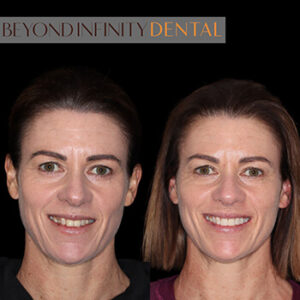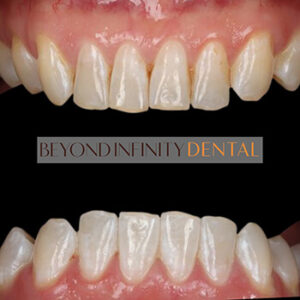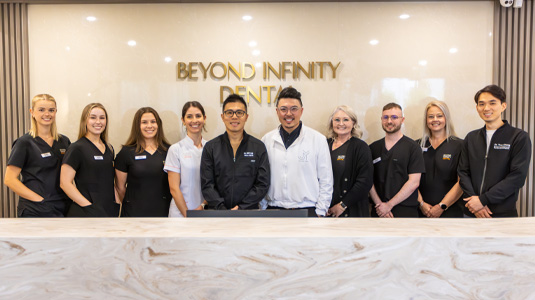If you are considering cosmetic veneers to improve your smile, it helps to know the type of veneers available. This post will discuss the four most common dental veneers and their advantages. So let’s get started.
Type #1 – Porcelain Veneers
Porcelain veneers have many advantages. Firstly, they’re incredibly versatile in that they can cover up surface damage like craze lines, small cracks, or chips. They can also camouflage flaws like blemishes or create uniformity between unevenly sized teeth. To this end, porcelain veneers are a highly utilised appliance in any cosmetic dentist’s toolbox.
Moreover, and unlike natural tooth enamel, porcelain veneers are non-porous and, therefore, highly stain resistant. As a result, patients can afford better protection for their new smile for longer.
 Finally, porcelain veneers are proven to be long-lasting if cared for properly. One long-term study found that the estimated survival rates for veneers based on 84 patients were 94% after five years, 93% after ten years and 82% after twenty years.
Finally, porcelain veneers are proven to be long-lasting if cared for properly. One long-term study found that the estimated survival rates for veneers based on 84 patients were 94% after five years, 93% after ten years and 82% after twenty years.
Because porcelain veneers are custom-made, they are initially more expensive than any other type of veneers, but as stated above, any initial cost can be counter-balanced by their possible longevity.
The procedure for porcelain dental veneers can either be carried out in two visits using conventional methods or while you wait, using CEREC technology. Additionally, the process is minimally invasive compared to other alternatives, such as a dental crown. It does, however, involve removing a small amount of tooth enamel, meaning that once you decide to have them, there’s no turning back.
In essence, porcelain veneers can provide a dramatic and long-lasting change to a smile without requiring more invasive treatments.
Type #2 – Composite Veneers
Another type of veneers is composite resin, which offers a less costly alternative to porcelain but typically doesn’t last as long. According to one 2014 review, the longevity of composite veneers in posterior teeth barely lasts five years. A short lifespan is due to the fact that composite resin isn’t as strong as other materials. But in addition, it can also be prone to heavy staining. Therefore if you do opt for composite dental veneers, you will need to consider what you eat and drink if you want to preserve the lifespan of your cosmetic treatment.
The main difference between composite and porcelain alternatives is that while porcelain veneers need to be designed, fabricated and bonded to the tooth’s front surface, composite veneers are made of resin, which can be mixed and applied chairside by your dentist. Once the resin is applied, it’s hardened using a curing light and then polished and buffed for a flawless finish.
Additionally, removing any tooth enamel before applying the composite mixture to the teeth isn’t typically necessary, so treatment can be completed in one sitting. Moreover, composite is more conservative than porcelain. When a composite veneer chips, it can be easily repaired, whereas the entire veneer needs replacing when porcelain chips.
Type #3 – Partial Veneers (Onlays)
While dental veneers are designed to cover the entire front surface of the tooth, a dental onlay is intended to cover the compromised areas of the tooth, such as areas of dental erosion or larger cavities. Although typically crafted from porcelain, onlays are more of a restorative solution than a cosmetic one per se.
Because onlays only partially cover a section of the tooth, they avoid the need for a dental crown. Ultimately, fitting a dental onlay negates the need to reshape the entire tooth to accommodate the crown, thus preserving the integrity of the original tooth.
As a result, dental onlays are ideal if you have tooth cracks, partial fractures or minor tooth decay.
Type #4 – Lumineers
Lumineers are, in effect, a brand of dental veneer but are ultra-thin, typically just 0.2mm. They can replicate the shape and colour of natural teeth even more so than conventional dental veneers.
 Because they are super thin, there is usually no need to remove a layer of tooth enamel, making this type of dental veneer popular with people who don’t want to undergo an irreversible type of veneers process.
Because they are super thin, there is usually no need to remove a layer of tooth enamel, making this type of dental veneer popular with people who don’t want to undergo an irreversible type of veneers process.
The lack of preparation work required also means that Lumineers are typically less expensive than their traditional porcelain veneers, making them an ideal option for those looking to make cosmetic changes to their teeth on a budget.
On the flip side, because Lumineers are so thin, they stand a greater chance of chipping, which can shorten their lifespan. However, when cared for correctly, Lumineers can last equally as long, with an average lifespan of 10-15 years.
As you can see, there are advantages and disadvantages to any type of veneers, and understanding these factors means that you can make a better, informed decision when the time comes.
Infinity Dental Veneers at Beyond Infinity Dental
At Beyond Infinity Dental, We use our very own Infinity Veneers that utilise a unique blend of porcelain and adhesive cement to ensure that your cosmetic laminates remain colour-stable for longer while still achieving the translucency and sparkle that you require.
Dr Jack Yang is highly experienced in blending porcelain to achieve the exact colour shade you require. Each porcelain veneer is individually crafted and customised to ensure a flawless and seamless smile that you can be proud to own.
If you would like to learn more about any aspect of getting composite or porcelain veneers or about the various types, we invite you to book a smile consultation with Dr Jack. He’ll sit down with you, discuss what you would like to achieve and help you develop a treatment plan to achieve it.
To book your dental veneers consultation, call on (02) 8806 3799 or book online.
References
Pub Med – Clinical Performance of Porcelain Laminate Veneers For Up To 20 Years
https://pubmed.ncbi.nlm.nih.gov/22259802
Pub Med – Longevity Of Posterior Composite Restorations
https://www.ncbi.nlm.nih.gov/pmc/articles/PMC4293707









